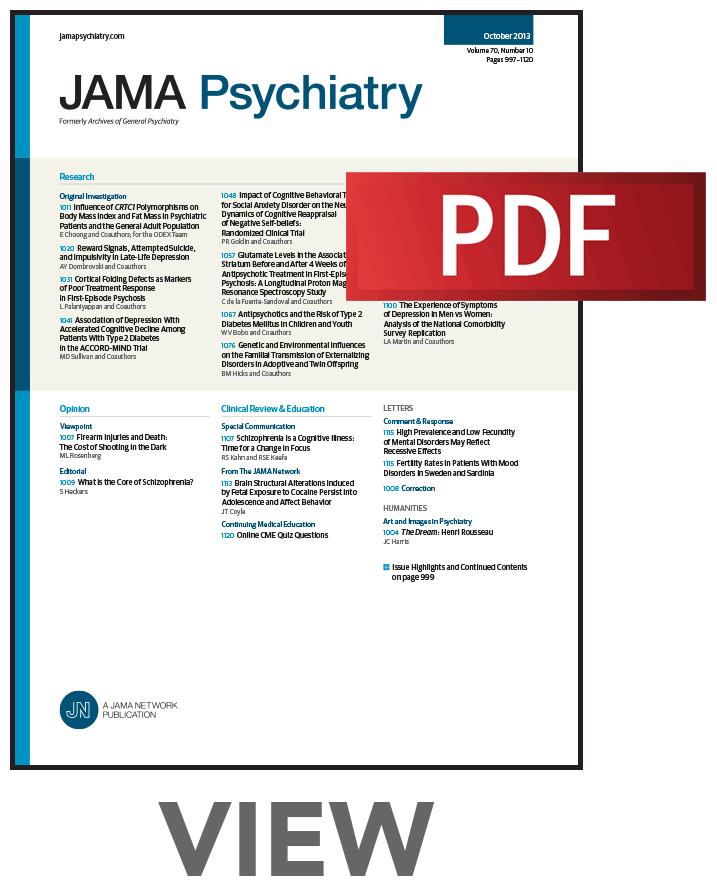Genetic Confounding in the Association Between Traumatic Brain Injury and Mental Disorder or Suicide
IF 22.5
1区 医学
Q1 PSYCHIATRY
引用次数: 0
Abstract
ImportanceTraumatic brain injury is common and occurs across all ages. Observational studies have shown that traumatic brain injury is associated with a wide range of mental disorders and suicide. Whether these associations represent a causal effect is, however, difficult to establish, and confounding by genetic liability for mental disorder may play a substantial role.ObjectiveTo investigate whether observational associations between traumatic brain injury and mental disorder or suicide could be confounded by genetic liability for mental disorder.Design, Setting, and ParticipantsThis cohort study was conducted from October 2023 to January 2025. The study population consisted of the general population subcohort of the Lundbeck Foundation Initiative for Integrative Psychiatric Research (iPSYCH) sample, which is a representative sample of the Danish population born between 1981 and 2008 that has been genotyped.ExposuresPolygenic risk scores (PRSs) for schizophrenia, bipolar disorder, depression, and attention-deficit/hyperactivity disorder (ADHD) calculated from the genotypes and genome-wide association summary statistics.Main Outcomes and MeasuresThe primary outcome was traumatic brain injury, operationalized via hospital diagnoses. The associations between PRSs for schizophrenia, bipolar disorder, depression, and ADHD, respectively, and traumatic brain injury were examined via Cox proportional hazards regression, yielding hazard rate ratios (HRRs) with 95% confidence intervals.ResultsThe final cohort consisted of a total of 40 274 individuals, of whom 19 802 (49.2%) were female. A total of 3341 (8.3%) of the cohort members (of whom 1464 [43.8%] were female and 1877 [56.2%] were male) experienced traumatic brain injury during follow-up. All 4 PRSs showed statistically significant positive associations with traumatic brain injury (PRS-schizophrenia: HRR, 1.06; 95% CI, 1.02-1.10;外伤性脑损伤与精神障碍或自杀之间的遗传混淆
创伤性脑损伤是常见的,发生在所有年龄段。观察性研究表明,创伤性脑损伤与多种精神障碍和自杀有关。然而,这些关联是否代表一种因果关系是很难确定的,而精神障碍的遗传责任可能起着重要作用。目的探讨外伤性脑损伤与精神障碍或自杀之间的观察性关联是否可能与精神障碍的遗传倾向相混淆。设计、环境和参与者本队列研究于2023年10月至2025年1月进行。研究人群由伦德贝克基金会综合精神病学研究倡议(iPSYCH)样本的一般人群亚队列组成,该样本是1981年至2008年出生的丹麦人口的代表性样本,已进行基因分型。根据基因型和全基因组关联汇总统计计算精神分裂症、双相情感障碍、抑郁症和注意力缺陷/多动障碍(ADHD)的多基因风险评分(PRSs)。主要结局和措施主要结局为外伤性脑损伤,通过医院诊断进行操作。通过Cox比例风险回归,分别检测精神分裂症、双相情感障碍、抑郁症和多动症的PRSs与创伤性脑损伤之间的关联,得出95%置信区间的风险率比(HRRs)。结果最终队列共40 274例,其中女性19 802例,占49.2%。随访期间,共有3341例(8.3%)队列成员发生外伤性脑损伤,其中女性1464例(43.8%),男性1877例(56.2%)。所有4种PRSs均与外伤性脑损伤呈正相关(PRSs -精神分裂症:HRR, 1.06;95% ci, 1.02-1.10;P = .002;prs -双相障碍:HRR, 1.04;95% ci, 1.00-1.08;P = .04;prs -抑郁:HRR, 1.10;95% ci, 1.06-1.14;P, amp;肝移植;措施;PRS-ADHD: HRR, 1.12;95% ci, 1.08-1.16;P, amp;肝移植;措施)。结论和相关性本队列研究的结果表明,精神障碍的遗传责任混淆可以解释创伤性脑损伤与精神障碍或自杀之间的一些关联。因此,精神障碍的遗传责任应纳入这些关联的未来研究,以避免对因果关系的高估。
本文章由计算机程序翻译,如有差异,请以英文原文为准。
求助全文
约1分钟内获得全文
求助全文
来源期刊

JAMA Psychiatry
PSYCHIATRY-
CiteScore
30.60
自引率
1.90%
发文量
233
期刊介绍:
JAMA Psychiatry is a global, peer-reviewed journal catering to clinicians, scholars, and research scientists in psychiatry, mental health, behavioral science, and related fields. The Archives of Neurology & Psychiatry originated in 1919, splitting into two journals in 1959: Archives of Neurology and Archives of General Psychiatry. In 2013, these evolved into JAMA Neurology and JAMA Psychiatry, respectively. JAMA Psychiatry is affiliated with the JAMA Network, a group of peer-reviewed medical and specialty publications.
 求助内容:
求助内容: 应助结果提醒方式:
应助结果提醒方式:


